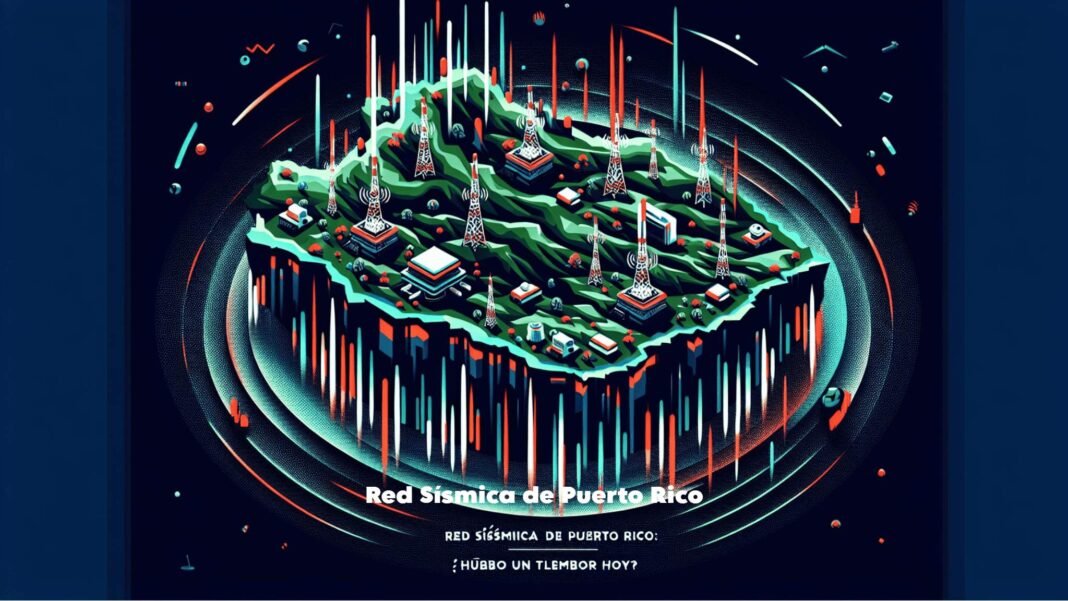The Red Sísmica de Puerto Rico Seismic Network (PRSN), established in 1976 through a cooperative agreement between the University of Puerto Rico and the United States Geological Survey (USGS), plays a pivotal role in monitoring seismic activity in Puerto Rico and the surrounding regions. With a mission dedicated to providing crucial seismic information and promoting earthquake and tsunami preparedness, questions like “¿Hubo un temblor hoy?” are addressed promptly by PRSN, ensuring the community stays informed and prepared. This network’s significance underscores the importance of real-time data for safety and awareness in earthquake-prone areas.
Operating an extensive network of seismic stations across Puerto Rico and the Virgin Islands, the PRSN, affiliated with the Department of Geology at the University of Puerto Rico at Mayagüez, not only offers real-time seismic data but also enriches educational and research opportunities in the field of geology. Staffed by a team of seismologists, geophysicists, engineers, and educators, Red Sísmica de Puerto Rico efforts are fundamental in promoting comprehensive earthquake and tsunami preparedness among the local communities. As part of the National Tsunami Hazard Mitigation Program (NTHMP), PRSN’s work is crucial in enhancing safety measures and public awareness regarding seismic risks in the region.
Historical Context
The establishment and evolution of the Red Sísmica de Puerto Rico Seismic Network (PRSN) have been pivotal in understanding and mitigating seismic risks in Puerto Rico and the surrounding regions. Initially installed in 1974 by the United States Geological Survey (USGS) for the Puerto Rico Electric Power Authority (PREPA), the network aimed to assess local seismicity crucial for the construction of the Aguirre and Islote nuclear power plants. This marked the beginning of a comprehensive approach to seismic monitoring in the area.
- 1974: Installation of PRSN by USGS for PREPA.
- 1987: Transfer of operation to the University of Puerto Rico in Mayagüez.
- 1997 & 2000: Modernization of data acquisition systems with IASPEI, SOUFRIERE, and ViSeis systems.
Puerto Rico’s geographical location at the boundary between the Caribbean and North American plates subjects it to frequent seismic activities. Historical records indicate earthquakes dating back to the early 17th century, with significant events shaping the island’s approach to seismic preparedness and response.
- Significant Earthquakes:
- 1670: First recorded earthquake, mainly impacting the San German area.
- 1787: An 8.0 magnitude earthquake causing extensive damage.
- 1918: A 7.5 magnitude earthquake in Aguadilla, generating a deadly tsunami.
The Red Sísmica de Puerto Rico’s continuous monitoring and data collection efforts have been crucial in understanding the seismicity of Puerto Rico and the Virgin Islands, akin to seismic activities observed in California and the Western United States. This historical context underscores the importance of the PRSN in promoting earthquake preparedness and enhancing safety measures in the region.
Understanding the Red Sísmica de Puerto Rico Network
The Red Sísmica de Puerto Rico Seismic Network (PRSN) has significantly advanced in its mission to monitor seismic activity, ensuring the safety and preparedness of the Puerto Rican community. At the heart of its operations, the PRSN, located at the University of Puerto Rico’s Mayagüez Campus, has inaugurated new headquarters, enhancing its capacity to process and analyze seismic data more efficiently. This strategic location also fosters collaboration with federal agencies such as the USGS, FEMA, and NOAA, crucial for issuing timely tsunami warnings and maintaining up-to-date seismic hazard maps.
Key Features of PRSN:
- Monitoring Tools: Red Sísmica de Puerto Rico’s station monitoring tool allows for real-time viewing of seismic traces, providing invaluable data for immediate analysis.
- Seismicity Portals and Catalogs: Offering detailed catalogs of felt and general seismic activity, the PRSN ensures comprehensive coverage of seismic events, including their location, magnitude, and timing.
- Collaborations and Accreditations: As an accredited member of the US Advanced National Seismic System (ANSS) and an active participant in international seismic monitoring groups, PRSN stands at the forefront of seismic research and response initiatives.
The network’s commitment to public safety is further demonstrated through its educational efforts and the promotion of basic and applied research in earth sciences. By operating a wide array of seismic stations and employing modern data acquisition systems, the Red Sísmica de Puerto Rico plays a pivotal role in understanding and mitigating seismic risks in Puerto Rico and the surrounding regions.
Recent Earthquake Reports
In the wake of recent seismic activities, the Red Sísmica de Puerto Rico (PRSN) has been diligently monitoring and reporting on earthquakes to ensure the safety and preparedness of the local community. Recent earthquake reports highlight the ongoing seismic activity in Puerto Rico and its surroundings, emphasizing the need for continuous vigilance and readiness.
- Recent Earthquake Activity:
- April 4, 2024:
- 3.66 magnitude in the Puerto Rico Trench, depth of 63 km.
- 3.85 magnitude in the Septentrional Fault Zone, depth of 27 km.
- April 2, 2024: 4.0 magnitude in the Eastern Dominican Republic, depth of 144 km.
- March 31, 2024:
- 3.84 magnitude in the 19° N Fault Zone, depth of 102 km.
- 3.75 magnitude in the Mona Canyon, depth of 5 km.
- Past 365 Days: 3,245 earthquakes, with the largest being a 5.7 magnitude in Tortola, British Virgin Islands.
- April 4, 2024:
The emotional toll of these quakes has been significant, with over a thousand individuals seeking refuge in government-run shelters. The American Red Cross has stepped in to assist those affected, like Lucila, who lost her home in the January 7 quake. The Red Sísmica de Puerto Rico’s efforts, alongside the USGS’s forecast of aftershocks persisting for years to decades, underscore the tectonic activity’s unpredictability and the importance of preparedness. Puerto Rico’s history of earthquakes, combined with the recent surge in activity, highlights the critical role of the PRSN and collaborative efforts in monitoring seismic events and enhancing community resilience.
Preparedness and Response
In response to the ongoing seismic activities, the Red Sísmica de Puerto Rico (PRSN) has implemented comprehensive preparedness and response strategies, engaging the community through educational initiatives and drills. One notable effort is the participation of nearly 600 middle and high school students in the Meteorology Festival at the University of Puerto Rico, Mayaguez Campus, which is organized by the student chapter of the Society of Meteorology of Puerto Rico. This initiative not only raises awareness among the youth but also cultivates a culture of preparedness from an early age.
- Educational Initiatives and Drills:
- Meteorology Festival: Engages students in understanding weather-related phenomena, including earthquakes.
- CaribeWave 2016: A collaborative tsunami drill with federal, local, and regional agencies, emphasizing the importance of readiness.
- Annual Tsunami Evacuation Exercise (Caribe Wave Puerto Rico): Held on March 21, this exercise tests the island’s evacuation plans and procedures, ensuring community preparedness.
Furthermore, the Red Sísmica de Puerto Rico collaborates with various agencies such as NOAA, the National Meteorological Service, and the Puerto Rico Emergency Management Agency to enhance the island’s response capabilities. Through these partnerships, the PRSN offers vital resources like earthquake reporting, tsunami evacuation maps, and educational material on earthquakes and tsunamis. These resources are pivotal for the community’s preparedness, enabling individuals to respond effectively during seismic events. Additionally, the PRSN’s calendar of activities and the availability of disaster assistance programs underscore the network’s commitment to keeping the community informed and prepared, without inducing unnecessary panic or fear.
Collaborations and Technological Advancements
The Red Sísmica de Puerto Rico (PRSN) fosters a collaborative environment, leveraging both local and international partnerships to enhance seismic monitoring and preparedness. These collaborations not only strengthen the network’s capabilities but also ensure a comprehensive approach to seismic hazard management.
- Key Collaborations and Initiatives:
- Geological Survey Initiative: A major project funded by the USGS with over $1 million aims to update the seismic hazard map for Puerto Rico, providing critical data for risk assessment and mitigation strategies.
- Submarine Volcano Monitoring: In collaboration with the University of the West Indies Seismic Research Centre, PRSN monitors the activity of Kick-’em-Jenny, a submarine volcano, highlighting the network’s extended reach beyond Puerto Rico.
- Landslide Risk Reduction Network: This initiative brings together civil society organizations, researchers, and communities to focus on landslide risk reduction, showcasing PRSN’s commitment to community engagement and safety.
- Technological Advancements:
- Through partnerships with organizations like Tsunami.gov and the National Earthquake Information Center, PRSN leverages advanced technology for real-time data collection and dissemination. This ensures timely warnings and enhances the network’s response capabilities.
- PRSN’s accreditation by the US Advanced National Seismic System (ANSS) and active participation in UNESCO’s Intergovernmental Coordination Groups underscore its role in global seismic monitoring efforts.
These efforts underscore Red Sísmica de Puerto Rico’s pivotal role in not only monitoring seismic activity but also in educating and preparing the community for seismic events. Through strategic collaborations and the use of advanced technology, PRSN enhances the safety and preparedness of Puerto Rico and its surrounding regions.
Conclusion
Through the years, the Red Sísmica de Puerto Rico Seismic Network (PRSN) has established itself as a cornerstone of seismic monitoring and preparedness in Puerto Rico and its surrounding areas. Its dedicated efforts in providing real-time seismic data, enhancing educational and research opportunities, and fostering significant collaborations have significantly mitigated the risks associated with earthquakes and tsunamis. The historical context and the recent seismic activities underscore the unpredictable nature of tectonic movements in the region, highlighting the PRSN’s indispensable role in promoting safety and awareness among the community.
As the Red Sísmica de Puerto Rico continues to leverage technological advancements and foster collaborative initiatives, its impact extends beyond the realm of seismic monitoring. By engaging the community through educational initiatives and drills, and implementing comprehensive preparedness and response strategies, the PRSN not only enhances the community’s resilience but also sets a global benchmark for seismic preparedness. The network’s commitment to keeping the community informed, prepared, and resilient in the face of seismic events underscores the broader implications of its work, ensuring that Puerto Rico and its residents remain vigilant and ready to respond to future seismic challenges.
FAQs about Red Sísmica de Puerto Rico:
- What is Red Sísmica de Puerto Rico? Red Sísmica de Puerto Rico is the Puerto Rico Seismic Network, a system established to monitor seismic activity in Puerto Rico and its surrounding regions.
- How does Red Sísmica de Puerto Rico monitor seismic activity? Red Sísmica de Puerto Rico operates an extensive network of seismic stations across Puerto Rico and the Virgin Islands, equipped with monitoring tools and data acquisition systems for real-time analysis.
- What is the historical significance of Red Sísmica de Puerto Rico? Red Sísmica de Puerto Rico has played a pivotal role since its establishment in 1976, providing crucial seismic data and promoting earthquake and tsunami preparedness in the region.
- What are some recent earthquake reports provided by Red Sísmica de Puerto Rico? Recent earthquake reports include details such as magnitude, depth, and location of seismic events, helping to keep the community informed about ongoing activity.
- How does Red Sísmica de Puerto Rico promote community preparedness? Red Sísmica de Puerto Rico engages in educational initiatives, drills, and collaborations with agencies to enhance community awareness and readiness for seismic events.
- What technological advancements does Red Sísmica de Puerto Rico leverage in its monitoring efforts? Red Sísmica de Puerto Rico collaborates with organizations and utilizes advanced technology for real-time data collection and dissemination, ensuring timely warnings and effective response capabilities.


